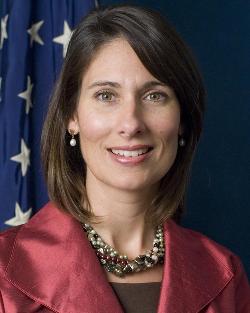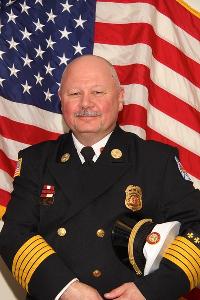 |
Deborah Hersman is president and chief executive officer of the National Safety Council. The National Safety Council saves lives by preventing injuries and deaths at work, in homes, communities, and on the roads through leadership, research, education and advocacy.
Prior to joining the National Safety Council, Ms. Hersman served as chairman of the National Transportation Safety Board. Ms. Hersman was first appointed as an NTSB board member by President Bush in 2004 and was reappointed to two additional five-year terms by President Obama in 2009 and 2013. Among her many initiatives as chairman, Ms. Hersman focused attention and actions on distracted driving, child passenger safety and helping victims and their families. Ms. Hersman was an NTSB board member on-scene for more than 20 major transportation incidents, chaired scores of NTSB hearings, forums and events and regularly testified before Congress.
Ms. Hersman was a senior advisor to the U.S. Senate Committee on Commerce, Science and Transportation from 1999-2004. She served as staff director and senior legislative aide to West Virginia Congressman Bob Wise from 1992-1999. Her efforts contributed to the passage of milestone bills such as the Motor Carrier Safety Improvement Act of 1999, Pipeline Safety Improvement Act of 2002, Transportation Equity Act of the 21st Century and Amtrak Reform and Accountability Act.
Ms. Hersman holds Bachelor of Arts degrees in political science and international studies from Virginia Tech, and a Master’s of Science degree in conflict analysis and resolution from George Mason University. She is a certified child passenger safety technician and holds a commercial driver’s license (with passenger, school bus and air brake endorsements) as well as a motorcycle endorsement.
Cheryl Michaels is the Associate Director for the Office of Safety and Security at Seattle Pacific University. As Associate Director, she oversees the campus security operations center, a 24/7 emergency dispatch center for the campus that also monitors surveillance systems, fire systems, and the campus emergency notification system. Since joining SPU in 2001, she has been responsible for implementing the university’s emergency and crisis management plan, which has included training for first responders and the campus community through seminars and exercises. She is the university’s lead advisor on threat assessments for at risk individuals. She is also responsible for the campus gender-based violence awareness program and a certified self-defense instructor with Rape Aggression Defense Systems. Before joining Seattle Pacific University, Cheryl worked for Raytheon’s naval weapons-manufacturing division in Security Operations, where she oversaw physical security and the classified information protection program.
Lessons Learned from the Seattle Pacific University Shooting
On June 5 2014, twenty-six year old Aaron Ybarra decided this would be the day the “world would feel his hate” and that afternoon shot and killed 1 student and injured 2 more at Seattle Pacific University. With no affiliation to the university, Ybarra had randomly selected SPU after spending weeks evaluating several different universities as targets. One student’s heroic intervention stopped Ybarra from harming more people. First responders, including two unarmed security officers who were the first to arrive on scene, provided life-saving medical aid to the wounded. The university’s security operations center was able to lock the entire campus down within fifteen seconds of receiving notification of shots fired, and a mass notification system alerting the SPU community was delivered in minutes. More than a decade of preparedness for such a possibility guided the university’s response and recovery efforts. This survey of the lessons learned will look at the culture of preparedness SPU developed; the response by university, police, EMS, and the media; as well as various actions taken during the ongoing recovery phase.
 |
Tim Pellerin currently serves as Fire Chief/EMA Director for Rangeley Fire/Rescue Department in Rangeley, Maine. Rangeley is a community of 3300 nestled in the western Maine mountains that swells to over 30,000 in the summer and winter months for recreational sports. Chief Pellerin along with 25 Paid on-call firefighters provide response and rescue for 19 towns, townships, villages, and unorganized territories covering over 800 square miles. In July 2013, Chief Pellerin along with 7 other fire departments and 30 firefighters responded to call for mutual-aid from the village of Lac-Mégantic Quebec for a rail train derailment with explosions. Together they operated for over 30 continuous hours to help control this terrible rail disaster. In April 2014, Chief Pellerin testified at the Rail Safety & Transportation hearing before the U.S. Senate, Committee on Appropriations, Subcommittee on Transportation, Housing and Urban Development (THUD) to help support funding for rail safety and disaster training in America.
Tim brings over 35 years of experience working through the ranks of emergency management and the fire service. He has served as a career firefighter/EMT since 1980, a fire officer since 1987, a hazardous materials technician since 1995 and in a Chief Officer capacity for over 20 years. Starting in the mid-1980’s he became a certified fire instructor, first at Maine State Fire Academy, then serving as lead instructor at Cumberland County Fire Attack School for Advanced Structural Fire Attack/Incident Command. Tim began serving as an emergency management director in the mid-1990’s and quickly became a nationally certified instructor for the Incident Command System. He was nationally honored by the Center for Domestic Preparedness as a recipient of the Bronze Level Authorized Instructor Excellence in Training award for 2009. Tim worked for 7 years as the Director of Lincoln County Emergency Management Agency and 9-1-1 Emergency Communications Center in Maine. During his time he helped develop an enhanced county wide firefighting training and operations programs including: Firefighter I and II, Incident Command, a flashover training facility, interoperable communications program, Community Disaster Response and Hazardous Materials programs. Tim also developed and led a certified Hazardous Materials Response Team, an Incident Command Team as well as a Mobile Field Communications Unit for 7 years.
Tim was raised and attended schools in Westbrook, Maine. He holds a Fire Science Technology Associates Degree from Southern Maine Technical College, is a Certified Emergency Manager, and holds a certificate in Professional Development from FEMA. He is certified as an NIMS/ICS Instructor, haz-mat Incident commander, water/technical rescue technician and wilderness/snowmobile rescue technician. Tim started his fulltime career in 1980 as a Firefighter/EMT for Town of Brunswick, Maine Fire Department, then went on to serve in other Maine communities including 16 years in the City of Portland, Town of Raymond, City of Westbrook, Town of Scarborough and now the Town Rangeley, Maine.


